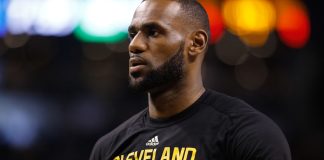The Atlanta Hawks have been stumbling toward the playoffs, but Tim Hardaway Jr. has been playing lights out all season long.
Atlanta is not the same team they were in the 2014-15 season when they finished as the top seed in the Eastern Conference. Three of their four All-Stars from that season are no longer with the team (Jeff Teague, Al Horford and Kyle Korver). Atlanta is struggling mightily to stay in the playoff picture in the East and it’s shown in their sliding record this year.
The Hawks have resorted to developing youngsters, which takes some growing pains. With the way the league is headed, that move was ideal for their long-term future. One of those young guys is Tim Hardaway Jr., who has responded with a career year.
Hardaway is playing a career-high 27.2 minutes per game, and that’s paid dividends. He’s putting up 14.4 points on 45.2 percent from the field, mostly as a sixth man. His effective field rate is also the highest of his tenure in the NBA at 53.4 percent.
Also Read: The Forgotten Legend Of Pistol Pete
He’s becoming a primary option to go to for the Hawks, especially with their best player Paul Millsap missing games recently due to a minor injury. Hardaway has expanded his scoring repertoire this year, as he’s no longer just a catch-and-shoot guy that he initially was with the New York Knicks.
Now, he’s someone who can come into the game off the bench and immediately provide a pop for your offense. Hardaway’s at his best coming off of screens and firing, and he makes more catch-and-shoot shots than any other Hawk with 1.6 per game (per nba.com).
Despite shooting the most of those on the team, he’s been getting the job done with defenders locked up within two feet of him as well. Taking that into account, Hardaway has the highest effective field goal rate of Atlanta’s guards (46.5 percent) on contested shots by players who have played the most for the Hawks. He’s also been clutch when the Hawks have needed him the most.
In a February game at the Houston Rockets, Hardaway had 33 points, including 23 in the fourth quarter alone. That allowed Atlanta to steal one on the road. He was showing the full array, as he went four-of-nine from three, and completely posterized Clint Capela in the final minute of the game to get a huge bucket. He also made numerous tough shots on drives, showing great dexterity by going off the glass in traffic with both hands.
He’s gotten much better as a ball handler and has shown the ability to make plays in pick-and-roll situations. That ability, combined with his knockdown jumper, makes him even tougher to guard. In an effort to build on that, he’s developing a great pull-up shot from midrange which keeps wing defenders off balance by making them decide whether or not they should commit to a close out.
Hardaway is getting better at recognizing how to keep trailing defenders on his back, and using his screener to keep them at bay. He’s shooting a career-best 40 percent from 3-10 feet out, which is far better than his career average of 30.2 percent. It’s clear Hardaway’s getting more comfortable maneuvering through defenses, and his handle has drastically improved. He almost brought the Hawks back from a huge deficit against the Cleveland Cavaliers in early March with a career-high 36 points in 35 minutes.
Nobody’s calling him “Tim Hardaway’s son” anymore.
The Hawks are a better team with Hardaway on the floor. He’s always had a sweet shooting stroke and had plenty of promise, but this season he’s been much more efficient, which was the next step in his progression as a guard in this league.
His player efficiency rating definitely could be better, as it’s just 14.9 (slightly below league average). However, his career-best true shooting rate has been impressive at 56.5 percent. The guy is not just shooting layups; he attempts so many high-degree-of-difficulty shots from all over the floor and converts a lot of them. Additionally, he’s starting to be more of a playmaker within the scope of the Hawks offense.
Also Read: Dwight Howard Wholeheartedly Believes He’s a Hall of Famer
He is slowly becoming a better passer when he penetrates in both the halfcourt and transition. Hardaway has a career-high with 2.2 assists per game and an assist percentage of 13.9, per Basketball Reference.
The game is starting to come to him more naturally. Thursday night was a prime example. He posted a stat line of 23 points, five boards and five dimes against the Boston Celtics in a 123-116 win to keep the Hawks fifth in the Eastern Conference standings. When Atlanta needed big plays, he made them.
Lastly, Hardaway is playing better defensively. I’m not sure if he’s ever going to have that patented “two-way player” label, but he’s at least gotten to be a solid team defender. His defensive win shares are better than they’ve been in his first three seasons, with 1.9, and it’s a key reason why Mike Budenholzer keeps him on the floor in crunch time.
Hardaway’s total win shares have spiked as a result of his better play on both ends, with a career-best 4.3 overall. His value over replacement player metric is also his best in his fourth season at 0.7, which is decent as he’s playing with lesser talent around him. Being a restricted free agent this coming offseason, Hardaway is going to get a big payday that’s more than warranted.
Follow me on Twitter

